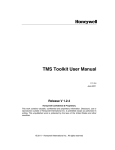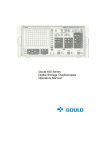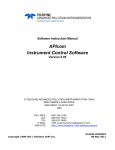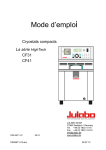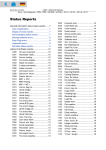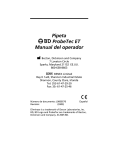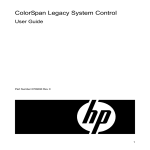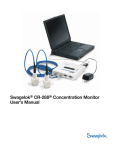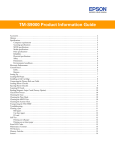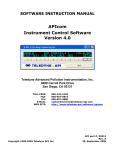Download TMS 9000 Torque Measurement System
Transcript
Sensotec - Lebow Operating Instructions for the TMS9000 Torque Measurement Sensing and Control Rev D: Nov. 2006 008-0688-00 TMS 9000 Torque Measurement System November 2006 008-0688-00 Intended Use Rotating torque sensors are intended for use between a power source and its load. They may be used to measure the power output of a drive (such as an electric motor or gasoline engine) 2 Honeywell • Sensing and Control and a suitable load. They are also used to measure the torque required to operate a given load. November 2006 TMS 9000 Torque Measurement System 008-0688-00 Operating Principles coupling module, and a signal processing module. Torque Sensor Lebow Torque Sensors are designed structures that perform in a predictable and repeatable manner when a torque is applied. This torque is translated into a signal voltage by the resistance change of strain gages, which are attached to the torque sensor structure. The change in resistance indicates the degree of deformation, and in turn, the torque on the structure. The strain gages are connected in a 4 arm Wheatstone Bridge configuration which acts as an adding and subtracting electrical network and allows compensation for temperature effects as well as cancellation of signals caused by extraneous loading. When the torque sensor is rotating, a means must be provided to transfer an excitation voltage to the rotational element from a stationary surface, and also to transfer the torque signal from the rotational element back to the stationary surface. This is accomplished through the use of digital telemetry. The receiver-transmitter module is an integral part of the torque sensor and is connected to the strain gauges and to the epoxy glass annular printed circuit board that contains the rotating antenna system. Within the receiver-transmitter module, the sensor signals are amplified, digitized, and are then used to modulate the radio frequency carrier wave that is detected by the antenna after being transmitted across the air gap by the caliper coupling module. That same carrier wave is rectified to provide power to drive the strain gauges and the electronic components in the module, which is managed by a miniature microprocessor. The caliper coupling module connects to the signal processing module via a simple co-axial cable. The detector circuitry in the signal processing module recovers the digital measurement data from the torque sensor and passes it to the second microprocessor for scaling and linearizing. The third microprocessor provides the drive to the two analog outputs, as well as the standard digital interfaces and the optional digital interface modules. Extensive facilities are provided in software for setup and configuration of the complete system. Principle of Telemetry The digital telemetry system consists of a receiver-transmitter module, a caliper-style Bolting Information Tighten all bolts, in incremental steps, to the bolt manufacturers rated torque specification. Use the respective sequence illustration shown below depending on the number of bolts the sensor requires. This bolting sequence applies to both bolt circles of the torque sensor. 1 1 1 10 8 6 8 8 4 3 11 12 4 5 4 5 7 2 3 6 3 4 10 6 3 6 1 5 2 9 7 2 5 9 2 7 Honeywell • Sensing and Control 3 TMS 9000 Torque Measurement System November 2006 008-0688-00 Installation and Set-up Torque Sensor The TMS 9000 series torque sensors may be operated horizontally, vertically, or any angle in between provided the load is applied through the loading axis. All torque sensors in this series have bolt patterns that mate directly to standard industrial couplings. When mounted, one of the flanges should be mated to a good quality double flex coupling or a driveshaft arrangement that incorporates universal joints at each end. This is designed to compensate for angular and parallel misalignment. Avoid applications that place extraneous loads on the torque sensor. Caliper Coupling Module The caliper coupling module must be firmly mounted to a non-rotating support structure. It must be aligned with the epoxy glass annular printed circuit board antenna so that the air gap between the caliper and the antenna is approximately equal on both sides. Care should be taken to avoid any items touching one another, and consideration should be given to the effects of vibration as well as the free play in any driveshaft sliding joints. To assist in the process of aligning the caliper and the antenna, a simple plastic alignment tool is provided with each system. The tool is used to hold the required clearance between the caliper and the antenna while the caliper fixing bolts are being tightened, and then is removed before the sensor is rotated. The tolerances for end-float (axial) are +/4.5mm (+/- 3/16”) and for run-out (radial) are +/1.0mm (+/- 1/16”). For installations where runout cannot be controlled within the specified tolerance, the secondary coupling position can be used. This is achieved by placing the edge of the caliper in close proximity to the edge of the antenna. In this position, the run-out tolerance can be at least doubled, at the expense of a reduced signal to noise ratio caused by the higher incidence of data drop outs. The axial 4 Honeywell • Sensing and Control tolerance is limited by the distance between the caliper sections. The caliper can also be mounted such that only one side is in proximity to the antenna, if the mounting arrangement does not allow for placing of the antenna between the two sides of the caliper. Successful positioning of the caliper can be confirmed by the presence of the ROTOR ACTIVE light on the signal processing module. The length of the RF cable connection between the caliper coupling module and the signal processing module is critical to system performance (due to reflections and standing waves). When using RG58 50-ohm cable, the length must be maintained at 13.9 metres (45’6’’ feet) or a multiple thereof. When using Belden 89907 cable, length must be maintained at 17.6 metres (57 feet) or a multiple thereof. For cable runs of less than 0.6 metre (2 feet), the cable that is provided with the unit can be cut to the required length. Otherwise, simply coil up any excess length. Signal Processing Module The receiver is mounted remotely with the coaxial cable being the only connection between it and the caliper coupling module. The receiver has holes provided for permanent mounting. Request the appropriate certified drawing from Lebow before making fixtures. When deciding where to locate the signal processing module, consideration should be given to the type of output that will be used. If the analog voltage or current output is to be used, then the signal processing module should be mounted in an area of low electrical noise and the connection between the module and the data acquisition equipment should be as short as possible and should be made up from double screened twisted pair cable. If the frequency output or the digital output is to be used, then the signal processing module can be mounted in the electrically noisy area provided that good quality dual screened twisted pair cables are used. November 2006 TMS 9000 Torque Measurement System 008-0688-00 Electrical Connections The signal processing module features twopart plug and socket connectors and the connection details are shown in Figure 2. All cable connections should pass through the cable glands, which when properly assembled, provide adequate sealing to allow the module to be operated in NEMA4 or IP65 environmental conditions (occasional water splash). The RF connection is made via the standard BNC connector, and IP65 rated cable assemblies can be supplied upon request. Figure 2 JTAG Connectors J9 SCU Primary Configuration port Port Secondary (expansion) Expansion port Port RS485 A RS485 B RS232 V+ RS232 RXD RS232 TXD RS232 0V RS485 A RS485 B RS232 V+ RS232 RXD RS232 TXD RS232 0V Power 0V Power +12V J10 DLU Expansion connector J14 J2 RF Carrier J7 ME0141-A ME0141-B J6 5-15kHz (0V) 5-15kHz J4 4-20mA 4-20mA (0V) J5 ±10V ±10V (0V) J3 ID label J8 Expansion Connector J13 J1 BNC connector to Calliper module Via standard RG58 co-axial cable: Length 13.9m (45.6 ft) or multiples thereof Via standard Belden 89907 cable: Length 17.6m (57 ft) or multiples thereof. Honeywell • Sensing and Control 5 TMS 9000 Torque Measurement System TABLE 1: Connector and Jumper Functions Connector J1 J2 J3 J4 J5 J6 J7 J8 J9 J10 J11 J12 J13 J14 JP1 JP2 JP3 JP4 6 Honeywell • Sensing and Control Function DC Power 12 V Primary RS485 port Secondary RS485 port Current loop output Voltage output Frequency output Primary RS232 port NOTE - THIS IS THE DEFAULT COMMUNICATIONS PORT Secondary RS232 port Factory use only Factory use only Expansion port Memory expansion port Primary RS232/RS485 default select Secondary RS232/RS485 default select November 2006 008-0688-00 November 2006 TMS 9000 Torque Measurement System 008-0688-00 Command Set Below is the list of parameters supported by the TMS 9000 (corresponding to firmware version v1.38) : Parameter Name #A Description Data Type Mode reporting access used by TMS Toolkit software to extract parameter information from the device. Read only #AnOutHigh Sets or returns the value in engineering units applied to the input that will give 100% (maximum positive full scale) output on the analog outputs. To invert the output polarity, enter the required negative full scale output value. Sets or returns the value in engineering units applied to the input that will give 0% (minimum negative full scale) output on the analog outputs. To invert the output polarity, enter the required positive full scale output value. Read/write AuxBaud Not yet supported. Read/write AuxOPType Not yet supported. Read/write BaudRate Not yet supported. Read only *CalCnts1*CalCnts9 #CalPoints Internal calibration data. This is read only via TMS Toolkit and is viewable only in “CAL” level access. These parameters are exposed to enable the saving and loading of calibration data only. Read only Sets the number of calibration points in use. Value must be between 2 and 9. Any change in #CalPoints should be followed by a #CalReset command to clear the previous unwanted calibration data from the memories. Read/write #AnOutLow #CalReset #CalValue1 to #CalValue9 #Counts ErrFlag Read/write NOTE – all calibration data and all analog output setting data will be cleared by #CalReset. It is recommended to save the parameter list before invoking #CalReset. Resets all calibration information. When the reset command is issued, all calibration data and all settings of the analog outputs (#AnOutHigh and #AnOutLow) are cleared so no reliable output will be available until all of the calibration points specified by the #CalPoints parameter and the required values of #AnOutHigh and #AnOutLow have been entered. Command NOTE – all calibration data and all analog output setting data will be cleared by #CalReset. It is recommended to save the parameter list before invoking #CalReset. These values are written in engineering units when the appropriate load is applied. Each of the nine parameters can be written at any time. See Calibration section later in this document. NOTE – the values entered MUST be in ascending order, starting with #CalValue1 (negative values count as lower than positive values). The number of calibration points entered must be equal to the number of calibration points activated by #CalPoints. Read/write NOTE – the existing calibration data is overwritten by any new input of #CalValue1~9. It is recommended to save the parameter list before entering new values. Returns the raw A-D counts value derived from the ADC on the rotating sensor. The ErrFlag parameter will indicate any errors that have occurred by returning a numeric value that is comprised of binary values representing the various error states. i.e. the binary values for each error are added together to produce the ErrFlag value. The error states are not retained between power cycles. Decimal Value 0 1 2 4 Read only Read only Error Description No error. Power cycled. Output clamped. Watchdog reset. Once the errors have been read they can be reset using the RstErrFlag command. #FastMode Used to initiate raw throughput of data without scaling or filtering. Set this parameter to 1 to enable fast mode. This setting is volatile so the device will revert to normal mode after the next Reset or the next power-up. Set to zero to disable fast mode. When in fast mode, the internal raw A-D counts results are fed directly to the analog output (voltage or current) without any scaling or filtering, giving a data throughput rate of 8.8 kHz (when FiltLevel=1). NOTE - the frequency output is not supported in fast mode. The fast mode can be scaled in the user’s data acquisition system by using the shunt cal facility, and is intended to be used for dynamic measurements only. Read/write Honeywell • Sensing and Control 7 TMS 9000 Torque Measurement System FiltLevel November 2006 008-0688-00 Used to set the threshold of operation of the digital filter. Values are set as parts per 10000, meaning that to set a threshold of 10% of the sensor rated capacity, then FiltLevel=1000 For a % step change in input, which is greater than (FiltLevel / 10000 * 100%), the new input value will be passed immediately to the output. For a step change in input, which is below the threshold set by FiltLevel, the output is filtered according to the setting of FiltSteps. Read/write #M NOTE – when FiltLevel is set to 0 or 1, digital filtering is disabled. Factory default value is 100, representing a threshold of 1% of sensor rated capacity (refer to the factory calibration data sheet or the rating plate attached to the sensor to confirm the rated capacity) Used to set the response time of the digital filter. Used in conjunction with FiltLevel to control the digital filtering behavior. Value range is 1 through 1000. Filtering takes the form of an RC equivalent where a change in input value, which is greater than the threshold set by FiltLevel, causes the output value to be incremented in the number of steps set by FiltSteps. The filter refresh rate is 1200 Hz. Factory default setting is 10, which in conjunction with the factory default setting of FiltLevel=100 provides for an output increment in the form of (x/2, x/3, x/4, x/5, x/6 …. x/10) where x=step change in input of more than ((FiltLevel/10000)*rated capacity). Given the filter update rate of 1200 Hz, the settling time to 63% final value will be 8.3 ms (Update rate divided by FiltSteps) and to 1% final value will be 41.7 ms (Update rate divided by FiltSteps x 5). The settling time to 0.1% final value will be 58.3 ms (Update rate divided by FiltSteps x 7). Mode reporting access used by TMS Toolkit software to extract parameter information from the device. Model Returns the model name (TMS) OpType ParaCnt Sets or returns the currently selected analog output where 0=current; 1=voltage; 2=frequency 10 kHz; 3=frequency 60 kHz, 4=current and frequency 10 kHz, 5=voltage and frequency 10 kHz, 6=current and frequency 60 kHz, 7=voltage and frequency 60 kHz. Returns the number of parameters in the device. ParaItem Set to the index number of the required parameter. Write ParaList Returns the information on the parameter indexed by ParaItem. Format: 'index,paraname,type’ a string. Read string FiltSteps Read/write Read only Read only string Read/write Read The value of type indicates the parameter’s properties by the addition of the following numerical values: 1 2 4 32 64 128 Readable Writeable Command String Numeric Boolean Example: ‘1,MODEL,33’ In the above example where type = 33 the parameter MODEL is a readable string. Percent Returns the value of the applied torque in percentage terms (0-100) where this range is the selected range over which the analog outputs work and is set by #AnOutLow and #AnOutHigh. Read only Reset Reset command to restart device and to implement parameter changes that require a reset. Command RstErrFlag Reset all error flags. Command SysZero Allows manual setting of the current Value or querying of the current zero offset being applied. The returned value is the amount of zero offset being applied to the true Value. To zero the system, this parameter should be set in engineering units to the value read when the system is supposed to be displaying zero. The action of SysZero may be limited by #ZeroLimit as described above, in which case the flag ZeroOK will be set to 0. Note that when any calibration parameter (#CalValue1~9, #CalReset) is changed, the value of SysZero is set to 0 and any zero offset is cancelled. This function, when used with #ZeroLimit, allows the current Value to be offset to any desired level (remember to consider the dynamic loading range of the sensor itself when applying large offsets) Read/write 8 Honeywell • Sensing and Control TMS 9000 Torque Measurement System November 2006 008-0688-00 Value Text memo field in which the name of the engineering units used for calibration can be stored for recall later. Note that when reading some characters via a 7-segment display (TMS Toolkit uses a virtual 7-segment display), some characters such as M will not display correctly. Returns the value of the applied torque in calibrated engineering units. Read only Version Returns the software version Read only ZeroNow Sets the current Value to zero unless limited by #ZeroLimit as described above. The action performed by ZeroNow is to clear any previous zero offset then compare the true Value to #ZeroLimit, then, to the extent allowable by #ZeroLimit, write the true Value to SysZero, resulting in a new current Value of zero Returns indication of 1 if the previous ZeroNow command was successful in setting the current Value to zero and returns 0 if the action was limited by #ZeroLimit. The limit in engineering units at which the ZeroNow command will be allowed to operate, relative to the computed Value at zero load that was stored during the calibration process. Therefore #ZeroLimit represents the maximum allowable difference between the “calibration” zero and the “current” zero. If the ZeroNow command is issued when the current Value is greater than #ZeroLimit, then the current Value will be moved to the extent allowed by #ZeroLimit and the flag ZeroOK will be set to 0. Factory setting is 50% of the calibrated range. Note that #ZeroLimit is a bipolar setting, so it will be applied to both directions (+ and -) around the calibration zero value. Internal system zero data. This is read only via TMS Toolkit and is viewable only in “CAL” level access. This parameter is exposed to enable the saving and loading of calibration and zero data. Command Units ZeroOK #ZeroLimit *ZeroPVal Read/Write Read only Read/Write Read only Honeywell • Sensing and Control 9 TMS 9000 Torque Measurement System November 2006 008-0688-00 System Calibration The TMS 9000 features nine-point linearization and all calibration is achieved using the following parameters: #CalSteps #CalReset #CalValue1 #CalValue2 #CalValue3 #CalValue4 #CalValue5 #CalValue6 #CalValue7 #CalValue8 #CalValue9 The minimum number of calibration points is 2. Calibration points can be created in any order provided that the values they contain are in ascending order starting with #CalValue1. Therefore, the lowest or the most negative (counter-clockwise) calibration point should be designated as #CalValue1. The number of calibration points that are in use is set by the parameter “#CalPoints”. Any change to the value of #CalPoints should be followed by the issuance of a “#CalReset” command, to clear the old calibration values from the EEPROM memories. Calibration is achieved by applying known loads at each of the calibration points that are selected for use and then writing the engineering units value to the appropriate #CalValuex parameter. The analog outs are precalibrated in the factory, so calibration of the input to the required output range is automatic and is dependent on the values entered for the parameters #AnOutHigh #AnOutLow #AnOutHigh and #AnOutLow are written-to using the engineering units value at which the analog outputs are required to give the maximum and minimum outputs. 10 Honeywell • Sensing and Control Available analog outputs are : Voltage range is –10 to +10 volts. Current output range is 4 to 20 mA. Frequency range is 5 kHz to 15 kHz or alternatively, 40 kHz to 80 kHz Calibration Example: To calibrate from –100 to +100 Nm in five steps of –100, -50, 0, +50 and +100 Nm: • • • • • • • Set #CalSteps=5 #CalReset Apply –100 Nm and set #CalValue1=-100, Apply –50 Nm and set #CalValue2=-50 Apply 0 Nm and set #CalValue3=0 Apply +50 Nm and set #CalValue4=50 Apply 100 Nm and set #CalValue5=100 • To obtain a frequency output of 5 kHz at 10 Nm and 15 kHz at 80 Nm then the parameters would be #AnOutLow=10 and #AnOutHigh=80. The device will then be fully calibrated. Note that for best results and to conform to accepted calibration practice, the unit under test should be exercised three times at the full load in the direction of loading prior to the setting of calibration points. This is especially important when calibrating in both the clockwise and the counterclockwise directions. Please contact the factory for a detailed description of calibration practice and procedure. If an alternative analog output is selected at a later date, or if different settings are chosen for the #AnOutHigh/Low parameters later, it is not necessary to repeat the loading calibration because all analog outputs are digitally driven. TMS 9000 Torque Measurement System November 2006 008-0688-00 Troubleshooting Problem “Power On” light is not showing “Rotor Active” light is not showing Shunt calibration does not operate Cannot communicate. Possible Solutions Check that 12VDC is being applied to the correct terminals (J1) and at the correct polarity. In certain cases, for example where the caliper coupling module has been left in direct contact with a metal surface for some time, the internal thermal protection circuit may have activated. To reset this condition, remove power and wait ten minutes before restoring power. Check that the RF cable is in good condition and is of the correct length (look for damage to the outer sheath that may indicate that the cable has been crushed at some time). Check that the caliper coupling module has been correctly positioned in close proximity to the rotating antenna. Use the positioning guide that was supplied with the system to confirm the position. Move the caliper coupling module to try and achieve coupling in an alternative position. Check that there are no metal parts (flanges, covers, etc), within one and a half inches (40mm) of the caliper coupling surfaces. Check that the power supply is actually 12 VDC when the caliper coupling module is in the appropriate position (some power supplies have built-in protection circuits that cause a reduction in supply voltage when current demands increase). Check that the “Rotor Active” light is showing, prior to using the shunt calibration function. Check that the RF cable is in good condition and is of the correct length (look for damage to the outer sheath that may indicate that the cable has been crushed at some time). Check that the caliper coupling module has been correctly positioned in close proximity to the rotating antenna. Use the positioning guide that was supplied with the system to confirm the position. Move the caliper coupling module to try and achieve coupling and shunt cal functionality in an alternative position. Check that there are no metal parts (flanges, covers, etc), within one and a half inches (40mm) of the caliper coupling surfaces. Check that the power supply is actually 12 VDC when the caliper coupling module is in the appropriate position (some power supplies have built-in protection circuits that cause a reduction in supply voltage when current demands increase). Check all wiring. If using the RS232 port, check that the Rx pin of the host computer is connected to the Tx pin of the TMS 9000 and vice versa. Check that the communications cable being used is of high quality or try a shorter length of cable (RS232 is sensitive to cable length and grounding issues, especially when used with laptop computers where grounding is uncertain). Honeywell • Sensing and Control 11 TMS 9000 Torque Measurement System Cannot communicate. 12 Honeywell • Sensing and Control November 2006 008-0688-00 Check that the correct serial port is selected in the software or TMS Toolkit. When using Windows, the serial port in use can be found by using the CONTROL PANEL, SYSTEM, HARDWARE, DEVICE MANAGER, COM ports functions. On older desktop PC’s, the COM1 port is already in use for the mouse, so a different COM port should be selected. If using a USB to Serial adapter, Windows assigns the COM port designations dynamically so they may change whenever the system is rebooted. The serial port settings are automatically modified by TMS Toolkit so there is no need to change any of the settings in Windows. The baud rate setting in TMS Toolkit should always be 38400 because that is the default baud rate of the TMS 9000. The “TMS ID” should be left blank because TMS Toolkit will search the connected port for any TMS device and will commence the communication automatically if present. Refer to the TMS Toolkit User Manual for more information November 2006 TMS 9000 Torque Measurement System 008-0688-00 Conversion Table Imperial-Metric conversion Foot-pounds 1 2 3 4 5 6 7 8 9 10 20 30 40 50 60 70 80 90 100 200 300 400 500 600 700 800 900 1000 2000 3000 4000 5000 6000 7000 8000 9000 10000 20000 30000 40000 50000 60000 70000 80000 90000 100000 inch-pounds 12 24 36 48 60 72 84 96 108 120 240 360 480 600 720 840 960 1080 1200 2400 3600 4800 6000 7200 8400 9600 10800 12000 24000 36000 48000 60000 72000 84000 96000 108000 120000 240000 360000 480000 600000 720000 840000 960000 1080000 1200000 Nm 1.35575 2.7115 4.0673 5.4230 6.7788 8.1345 9.4903 10.846 12.202 13.558 27.115 40.673 54.230 67.788 81.345 94.903 108.46 122.02 135.58 271.15 406.73 542.30 677.88 813.45 949.03 1084.6 1220.2 1355.8 2711.5 4067.3 5423.0 6778.8 8134.5 9490.3 10846 12202 13558 27115 40673 54230 67788 81345 94903 108460 122018 135575 Metric-Imperial conversion Nm 1 2 3 4 5 6 7 8 9 10 20 30 40 50 60 70 80 90 100 200 300 400 500 600 700 800 900 1000 2000 3000 4000 5000 6000 7000 8000 9000 10000 20000 30000 40000 50000 60000 70000 80000 90000 100000 inch-pounds 8.85119 17.702 26.554 35.405 44.256 53.107 61.958 70.810 79.661 88.512 177.02 265.54 354.05 442.56 531.07 619.58 708.10 796.61 885.12 1770.2 2655.4 3540.5 4425.6 5310.7 6195.8 7081.0 7966.1 8851.2 17702 26554 35405 44256 53107 61958 70810 79661 88512 177024 265536 354048 442559 531071 619583 708095 796607 885119 foot-pounds 0.73760 1.4752 2.2128 2.9504 3.6880 4.4256 5.1632 5.9008 6.6384 7.3760 14.752 22.128 29.504 36.880 44.256 51.632 59.008 66.384 73.760 147.52 221.28 295.04 368.80 442.56 516.32 590.08 663.84 737.60 1475.2 2212.8 2950.4 3688.0 4425.6 5163.2 5900.8 6638.4 7376.0 14752 22128 29504 36880 44256 51632 59008 66384 73760 Honeywell • Sensing and Control 13 November 2006 TMS 9000 Torque Measurement System 008-0688-00 Specifications - Electronics Power supply 12 V DC +/- 10%, 0.75A 9W maximum Protection Reverse polarity connection or fault condition will trip the internal thermal fuse (self-resetting) 4-20 mA +/- 10 VDC 10 kHz +/- 5 kHz 60 kHz +/- 20 kHz (zero torque = 12 mA) (zero torque = 0 V) (zero torque = 10 kHz) (zero torque = 60 kHz) 4-20 mA +/- 10 VDC Frequency Input sampling rate • Anti-aliasing filter (fixed) Telemetry update rate Fast mode data throughput rate Normal mode data throughput rate Analog output bandwidth (max) Group delay (typical, normal mode) Group delay (typical, fast mode) • • • • • Output drive capability: • • • • • Analog output signals: • • • • Frequency response: 500 Ohms max 2 k Ohms min 4.0 V p-p into 100 k Ohms min load 1k Ohms 17,656 samples/sec 4.1 kHz 8.828 kHz 8.828 kHz 1.104 kHz 3 kHz @ -3 db 2.5 ms 1.2 ms Digital filtering: FIR mode IIR mode 0.1 through 1000 Hz recursive algorithm Digital resolution: • • Cable length: Normal mode Hi-res mode 16-bit ( 0.01 %FS) 19-bit (0.001 %FS) RF carrier frequency Using RG58 cable 13.9 meters (45’6”) or multiples thereof (max. 10x standard) 6.78 MHz Using Belden 89907 17.6 meters (57’1”) cable or multiples thereof Accuracy: • Electronics • Sensor • System 0.002% FS typical 0.050% FS typical refer to system calibration data sheet Temperature Range: • Operating • Compensated • • Zero temp stability Gain temp stability -40 to +85 C (-40 to 185 F) -10 to +50 C (14 to 122 F) <0.0025 %FS/C <0.001 %FS/C 14 Honeywell • Sensing and Control Enclosure rating: NEMA-4, IP65 EMC immunity: 10V/m (30MHz-1GHz) TMS 9000 Torque Measurement System November 2006 008-0688-00 Shunt Calibration An electrical signal equivalent to that produced by a known load can be obtained by activating the shunt calibration function. The shunt calibration function is built in to the sensor itself, and it is therefore necessary for the Rotor Active light to be showing before the function can be operated. By design, the caliper coupling module is more sensitive to receiving data than it is to transmitting data, therefore it may be necessary to adjust the caliper coupling module position to ensure good two-way communications, prior to using the shunt cal function. The shunt calibration function is achieved by connecting a high-precision resistor of know value, in parallel (shunt) with one arm of the strain gage Wheatstone bridge. The connection is made by a solid state switch, under the control of the microprocessor on the rotating sensor, when commanded by the remote Signal Processing Module. This switch can be activated via the pushbutton on the face of the signal processing module. The shunt calibration value is determined during factory calibration of the torque sensor. The shunt calibration function is a very useful aid when setting up the system or when fault finding. In applications where it is not possible nor practicable to perform dead weight system calibration, the shunt calibration function can be used as an alternative, at the cost of some loss of calibration accuracy. To provide for this eventuality, the shunt calibration value is factory-set to represent between 50% and 95% of full scale, and is achieved by using high grade resistors that exhibit very low thermal sensitivity. Storage and Recalibration This torque measurement system may be stored for an indefinite period in a dry place at room temperature. Recalibration should follow your normal instrumentation certification schedule. Honeywell • Sensing and Control 15 TMS 9000 Torque Measurement System APPENDIX SUPPLEMENTARY INFORMATION RELEVANT TO YOUR USER MANUAL TMS 9000 TORQUE MEASUREMENT SYSTEM. Appendix A – Supplement for TMS 9000 SPM Square Wave Output Option Appendix B – Supplement for TMS 9000 SPM Remote Shunt Cal Option Appendix C – Supplement for TMS 9000 SPM Digital Filter Settings Appendix D – Supplement for TMS 9000 FASTMODE Operation 16 Honeywell • Sensing and Control November 2006 008-0688-00 TMS 9000 Torque Measurement System November 2006 008-0688-00 APPENDIX A Manual Supplement for TMS9000 SPM Square Wave Output Option This supplement provides information on the operation and specifications of the TMS9000 SPM with the Square Wave Output Option, P/N 064-LW37040. Overview The Square Wave Output Option is a plug-in module for the SPM that converts the sine-wave analog frequency output of the SPM to a square wave that is compatible with most RS-422 and RS-485 type inputs to data acquisition systems and frequency/pulse counters. The frequency of the square wave is equal to the frequency of the standard sine wave output. The square wave output is available in three formats: positive phase (TTL level), differential (+/- 5 VDC), and negative phase (TTL level, 180 degrees out of phase compared to positive phase). Setup The Square Wave Output Option is installed and tested at the factory. A two-pin green mating connector and 120 ohm termination resistor is provided with the SPM to connect between the output option board and the customer supplied data acquisition system (DAQ), counter or other device. The following steps describe the process of connecting the SPM option board to the DAQ or counter. 1. Be sure AC/DC power supply module is not connected to a power source. 2. Place the SPM on a flat workbench or table, preferably with an ESD-safe mat or cover to dissipate electrostatic voltages. Wear an ESD-safe grounded wrist strap while working inside the SPM box. 3. Carefully remove the four screws of the SPM cover and slowly lift the cover off the SPM. Take care not to damage the ribbon and ground wires connected to the inside of the cover. 4. The square wave option module is installed just to the right of J3 and J8 on the main circuit board. A twisted pair jumper cable connects between J6 of the main board (frequency output) and the J1 (frequency input) on the option board. 5. Determine the desired output type. On the option board, the negative phase output is J2, differential output is J4, and positive phase is J5. The ground (common) point is on the left side of the output connectors J2 and J5. 6. Route the wires from the DAQ system through the conduit hole labeled “frequency” to the desired output connector on the option board. Twisted pair 2-conductor shielded wire is recommended for best performance. Strip off about ¼” of insulation from the wire and tin the ends with solder. Loosen the screws on the connector and slide the wires into the connector next to the resistor leads. Remember, the ground (or common) wire must be attached to the left side of the connector. 7. Re-attach the SPM cover and tighten the cover screws. 8. Continue with system installation as described in the TMS9000 user manual. Honeywell • Sensing and Control A-1 TMS 9000 Torque Measurement System November 2006 008-0688-00 APPENDIX B Manual Supplement for TMS9000 SPM Remote Shunt Cal Option This supplement provides information on the operation and specifications of the TMS9000 SPM with the Remote Shunt Cal Option, P/N 064-LW37039. Overview The TMS9000 SPM with Remote Shunt Cal option allows the user to remotely activate and deactivate the shunt cal mode via an external switch and cable. Setup The Remote Shunt Cal option is installed and tested at the factory. A six-pin circular connector is mounted to the front panel of the SPM box as a connection point for the remote shunt cal switch. A mating connector (023-LW181-034) is provided so the user can attach a cable between the SPM and the customer supplied switch. 1. Connect a two-conductor cable between the remote switch and the mating connector. Solder one conductor to pin A of the mating connector and the other conductor to pin B. Attach the strain relief to the connector. 2. Attach the mating connector to the six pin connector on the SPM. 3. After setting up the sensor and caliper module, power on the SPM and verify the Power LED and the Rotor Active LED is lit on the top of the SPM. Turn on the remote shunt cal switch and verify the Shunt Cal Mode LED is lit on the top of the SPM. Turn off the remote shunt cal switch and verify the Shunt Cal Mode LED turns off. 4. Setup of the Remote Shunt Cal Option is complete. Honeywell • Sensing and Control B-1 TMS 9000 Torque Measurement System November 2006 008-0688-00 APPENDIX C Manual Supplement for TMS9000 SPM Digital Filter Settings This supplement provides information on the operation and specifications of the TMS9000 SPM with the Digital Filter Settings, as they relate to v1.38 software. Intended Use This supplement is intended for the purpose of describing the function and operation of the digital filtering algorithms that are included in the TMS 9000 version 1.38 firmware. It should be used in conjunction with the TMS 9000 User Manual and the TMS Toolkit User Manual, both of which are supplied with a TMS 9000 Torque Measuring System. Filter Operation General Description The digital filter algorithm in the v1.30 and later firmware versions of the TMS 9000 is basically a recursive filter that behaves like an “RC” circuit. It has two user settings, the first being a “level” set by the parameter FiltLevel, and the second being a filter “weight”, set by the parameter FiltSteps. The “level” works as a threshold, above which the filter is reset to allow a fast response to a event that exceeded the threshold. This is useful in the case when well-damped steady state data is required, but when significant fast transients and disturbances should not be filtered out. the time constant of the RC filter, increasing the damping effect. The settings of any of the TMS 9000 parameters can be changed at any time via the RS232 communications link. Changing parameters while the system is running will take effect immediately, and in the case of filter setting changes, will become effective as soon as the filter flushes through. The TMS Toolkit software, supplied with the TMS 9000 system, simplifies the task of changing settings, although any character-based communications software could be used instead (e.g. HyperTerminal). The “weight” of the filter is set by increasing the number of filter steps, which in turn increases Filter Operation Detailed Description Consider the input signal as being Vi and the output signal being Vo In a steady state situation, Vo will equal Vi When Vi changes, the extent of the change is compared with the threshold, which is set as a proportion of the full scale sensitivity, by the parameter FiltLevel. If the change does not exceed the threshold, then the output value Vo is updated by a fractional amount of the new value Vi until the output value equals the input value again. The number of steps set by FiltSteps determines the number of fractional steps that are taken to increment the output value, according to the following series : 1 / 2, 1 / 3, 1 / 4, 1 / 5 ….etc If the change exceeds the threshold, then the new input value is passed immediately to the output, thereby resetting the filter. The output characteristic is therefore exponential and behaves in a predictable manner. Honeywell • Sensing and Control C-1 TMS 9000 Torque Measurement System To determine the settling time of the filter (the time taken to reach the Vo = Vi condition), it is necessary to know both the filter update rate and the number of fractional steps. The filter update rate is fixed at 1000 Hz in the firmware v1.30 and above, although other filter update rates can be made available upon request to the factory. November 2006 008-0688-00 The table below provides a quick reference to determine the filter characteristic Note that this filter operates only when the change in the input is below the threshold set by FiltLevel. The cut-off point (in Hz) is given by the expression Frequency (-3dB)= (update rate/number of steps)/6.3 Filter Settling Time The time required for the output to settle following a step change in input level is given by the following table. % of Final Value 63 % 99 % 99.9 % Time to Settle Filter Update rate * FiltSteps Filter Update rate * FiltSteps * 5 Filter Update rate * FiltSteps * 7 Where the Update Rate is the period in seconds (1/f), fixed at 0.001s for firmware v1.30 and above AND Where the change in input signal magnitude is below the threshold set by FiltLevel. Honeywell • Sensing and Control C-2 TMS 9000 Torque Measurement System November 2006 008-0688-00 Example There follows an example of typical filter settings as applicable to a standard production TMS 9000 torque measuring system. Consider a sensor with a 1000Nm full scale torque measuring range. Consider a test running at steady state torque of 550 Nm. Consider FiltLevel set at 1000. The unit of measure for FiltLevel approximates to 0.01%FS (where FS is the full scale of the sensor), therefore a FiltLevel of 1000 sets a threshold of change of 10% of FS which in this example is 100 Nm, above which the filter is reset and the output value becomes equal to the input value again. Note that the threshold is with respect to the current value, and not with respect to zero torque. Therefore, if the torque is fluctuating within a band of less than 100 Nm, the filter performance will be determined by FiltSteps alone. In the case where torsional vibrations and spikes may be present in the input signal, then the threshold set by FiltLevel should be raised so that the filter is not being reset by events which are not of interest. A safe value to use when setting up is 5000, which corresponds to 50% of FS, the reduce the threshold later if required. Now consider an input change of 0.1 Nm, which is below the threshold and therefore subjected to filtering. The difference between the input and the output is 0.1 Nm so this is the change that will be used by the filter comparator. If the FiltSteps parameter is set to 10, then the output of the TMS 9000 will be incremented towards the input in 10 steps, as follows : 1 / 2(0.1 Nm), 1 / 3(0.1 Nm), 1 / 4(0.1 Nm), 1 / 5(0.1 Nm), …. 1 / 9(0.1 Nm), 1 / 10(0.1 Nm) The filter update rate being 1000 Hz gives an update period of 1/1000=0.001 seconds, therefore the filter will settle to 63% of its final value in 0.01 seconds (being 0.001 * FiltSteps). Using the formula described in the table above, it can be seen that the filter will settle to within 99.9% of its final value in 0.07 seconds (being 0.001 * FiltSteps * 7) Honeywell • Sensing and Control C-3 November 2006 TMS 9000 Torque Measurement System 008-0688-00 Quick Look Up Table Desired Settling Time to 99.9% of Final Value (seconds) 7s 3.5 s 1.4 s 0.7 s 0.35 s 0.14s 0.07 s 0.035 s 0.014 s 0.007 s Equivalent to Cut-Off Frequency of (Hz) FiltSteps setting required 0.16 Hz 0.32 Hz 0.79 Hz 1.59 Hz 3.17 Hz 7.94 Hz 15.87 Hz 31.75 Hz 79.37 Hz 158.73 Hz 1000 500 200 100 50 20 10 5 2 1 NOTE : The setting of FiltLevel is of great importance when adjusting the filter settings. Unexpected torsional spikes and vibration noise can cause the frequent resetting of the filter. If in doubt, increase FiltLevel (range 1 through 100000) When FiltLevel=1, the filter is bypassed and the torque value is delivered to the output processor at a rate of 2207 Hz, thereby providing a 3dB cut-off of 350 Hz When FastMode=1, the scaling and linearizing algorithms are bypassed and the raw ADC count value is delivered to the output processor at a rate of 8828 Hz, thereby providing a 3 dB cut-off of 1400 Hz. Reference and Equations To calculate the setting of FiltSteps required for a particular 3dB cut-off frequency, use FiltSteps = Update rate / (Frequency * 6.3) To calculate the 3dB cut-off frequency for a particular setting of FiltSteps, use Frequency = ( Update rate / FiltSteps ) / 6.3 NOTE: the 3 dB point is also known as the half power point and occurs when the output voltage is equal to 71% of the input or output power is 50% of the input power. dBvolt = 20 Log10 dBpwr = 10 Log10 (Vout/Vin) (Pout/Pin) Honeywell • Sensing and Control C-4 November 2006 TMS 9000 Torque Measurement System 008-0688-00 Sample Charts INPUT : Square Wave, 0.1 Hz OUPUT : Analog Voltage FiltLevel=10000 FiltSteps=1000 Settling time to 99% is given by 5 * 0.001 * 1000 = 5 seconds INPUT : Square Wave, 0.4 Hz OUPUT : Analog Voltage FiltLevel=10000 FiltSteps=1000 Settling time to 99% is given by 5 * 0.001 * 1000 = 5 seconds Therefore overdamped response, only reaching 60% of full scale p-p value Honeywell • Sensing and Control C-5 November 2006 TMS 9000 Torque Measurement System 008-0688-00 Sample Charts INPUT : Square Wave, 16 Hz OUPUT : Analog Voltage FiltLevel=10000 FiltSteps=38 Settling time to 63% is given by 0.001 * 38 = 0.038 seconds Therefore overdamped response Honeywell • Sensing and Control C-6 TMS 9000 Torque Measurement System November 2006 008-0688-00 APPENDIX D Manual Supplement for TMS9000 SPM FASTMODE Operation and Settings This supplement provides information related to v1.30 firmware and above. Intended Use This supplement is intended for the purpose of describing the function and operation of the FASTMODE feature that is included in the TMS 9000 version 1.30 firmware and above. It should be used in conjunction with the TMS 9000 User Manual and the TMS Toolkit User Manual, both of which are supplied with a TMS 9000 Torque Measuring System Honeywell • Sensing and Control D-1 TMS 9000 Torque Measurement System November 2006 008-0688-00 FASTMODE Operation General Description The flow of data in the TMS 9000 is subjected to various forms of processing as it passes from input to output. This process is best described by use of a flow chart as follows : the amount of processing required – the TMS 9000 features independent scaling of the input and output, using floating point values for convenience of the user, and the linearizing routine can use up to 9 data points (user selectable), so a significant amount of processor power is consumed during these floating point calculations. The next process is digital filtering, using a parameter driven recursive algorithm that performs output smoothing but also provides a separate parameter that controls a filter bypass in the event of a significant change in input being required to be reflected through to the output without delay. The filtered data is then converted to the required analog output format or formats (the TMS 9000 can drive the voltage or current loop output at the same time as providing a frequency output) using the output scaling parameters that are independent from the input calibration. The rate at which the microprocessor can perform the separate linearizing and scaling calculations is the limiting factor in determining the available bandwidth of the TMS 9000. To provide a faster response for users that want to analyze the dynamic data, a FASTMODE is provided, and in this mode, the data is “piped” directly from the rotor to the analog voltage output. The benefit of this mode is that the analog voltage output is updated at the maximum data rate, which is eight times faster than the normal mode rate. The data is transmitted from the rotor at the maximum data rate but the rate has to be slowed down for linearizing and scaling due to The penalty of using fastmode is that the scaling and linearizing stages are bypassed, so the relationship between input and output becomes fixed, and the only way to calibrate the output against the input is to calculate the expected change in output value (by reference to the calibration data stored in the TMS 9000), or perform a physical system calibration or to use the SHUNT CAL feature. Honeywell • Sensing and Control D-2 TMS 9000 Torque Measurement System The following diagram shows the change in data flow when using FASTMODE. November 2006 008-0688-00 Because of the significant change in output characteristics that takes place when FASTMODE is selected, it is implemented as a VOLATILE setting, therefore recycling the power or performing a soft reset will return the TMS 9000 to NORMAL mode. As an indication to the user that FASTMODE is in operation, the ROTOR ACTIVE light on the lid of the TMS 9000 Signal processing Modules (SPM) is de-activated. Honeywell • Sensing and Control D-3 TMS 9000 Torque Measurement System November 2006 008-0688-00 FASTMODE Operation Detailed Description The strain gage input value is digitized at a rate of 17,656 samples per second with 24-bit resolution, but this amount of data is in excess of the capacity of the telemetry link, so it is reduced by the simple averaging of every pair of A-D results at the rotor electronics module. The data that is transmitted across the telemetry gap consists of 8,828 results per second at a resolution of 16-bit, and it is this data that is then piped directly to the analog voltage output whenever FASTMODE is turned on. The analog voltage output channel is a 16-bit digital-to-analog converter with a bandwidth of greater than 3 kHz, therefore the expected analog output voltage for a full scale torque measurement can be calculated by reference to the calibration data tables held in the TMS 9000. Assuming that the factory calibrated (or user recalibrated) data tables can be accessed using the CAL user mode of the TMS Toolkit, the output calibration can be determined using this theoretical method, an example of which will be given later. When the TMS Toolkit is not available, the user will need to perform a physical system calibration by placing a known torque on the sensor and measuring the change in the analog output voltage. In cases where the shunt calibration value is known, the change in output due to shunt calibration can be measured and the result extrapolated to give a full scale equivalent. Note that this result will need to be adjusted when the shunt cal scaling feature has been used (#SCSCALE is something other than 1). An example of calculating the analog output voltage by using shunt cal and the #SCSCALE parameter is also given later. Normal mode and FASTMODE data update rates The table below provides a quick reference to the data rates available in either of two available modes. Mode NORMAL NORMAL FASTMODE Data rate When FILTSTEPS>1, data rate is 1104 results per second When FILTSTEPS=1, data rate is 2207 results per second 8828 results per second Note that the analog voltage output channel should be only channel is use for any data rate above 1104 results per second. Therefore OPTYPE should be set to 1. Note that any traffic on the RS-232 port caused by TMS Toolkit or any other communications package will disrupt the flow of data due to the interrupts that are generated by the external software. Honeywell • Sensing and Control D-4 TMS 9000 Torque Measurement System November 2006 008-0688-00 Examples The following examples assume that either the TMS Toolkit is available and running in CAL user mode, or that a hard copy of the parameters list is available and is valid. Example 1 – Theoretical determination of analog output value The relationship between torque and digital counts can be determined by reference to the parameters held in the TMS 9000. When in FASTMODE, the digital counts received from the rotor are simply piped through to the analog voltage output channel, so the counts values can be used to determine the expected analog output values (actual values may vary within the calibration accuracy of the analog output channel, usually within 0.1%FS). Consider a sensor with a 2000Nm full scale torque measuring range Calibration values most likely to have been used will be (approximately) -2000, 0 and +2000 Nm The actual values used may have been adjusted to take account of local gravity and buoyancy and can be seen from the parameters #CALVALUE1, 2 and 3 Make a note of the actual values used and compare them to the values of #CALCNTS1, 2 and 3 The #CALCNTSx values store the digital counts values that were output by the rotor for the load conditions given by the relevant #CALVALUEx The analog voltage output channel is 16-bit and it will generate an output of -10V when it is driven by a counts value of 0, and will generate an output of +10V when driven by a COUNTS value of 65535. Therefore each count generates 0.0003052V starting from a base of -10V. The analog voltage output will be generated in direct relationship to the statement above. Therefore, using the following data, the analog voltage output will be: #CALVALUE1=-1998.699 #CALCNTS1=21553 Therefore at a load of -1998.699 Nm, the analog Voltage will be (21553*0.0003052)-10V = -3.422V #CALVALUE2=0.000000 #CALCNTS2=32700 Therefore at a load of 0 Nm, the analog Voltage will be (32700*0.0003052)-10V = -0.020V #CALVALUE3=1998.500 #CALCNTS3=43842 Therefore at a load of +1998.500 Nm, the analog Voltage will be (43842*0.0003052)-10V = +3.381V Honeywell • Sensing and Control D-5 TMS 9000 Torque Measurement System November 2006 008-0688-00 Example 2 - Using the SHUNT CALIBRATION feature The shunt cal feature operates by switching-in a high precision shunt resistor across one of the arms of the strain gage bride on the rotor. The change in output that occurs due to this shunting is repeatable and is often used as a means of calibration. During factory calibration, the apparent change in torque output due to shunt cal will have been recorded, and this value can be used to re-calibrate the analog voltage output when in FASTMODE. Consider a sensor with a 2250 Lbf.in measuring range. The factory calibration certificate will include the changes due to shunt cal as a list of effects such as follows : When in FASTMODE, the shunt cal values for voltage, current and frequency are invalid because the scaling module is bypassed, so the only piece of information that remains valid and that we need to use from this data table is the apparent change in TORQUE due to shunt cal, and in the case of this example, it is 1692.2 Lbf.in It follows that the change in analog voltage output when in FASTMODE will represent 1692.2 Lbf.in The exception to this case will be when a value has been set for #SCSCALE. This parameter allows the effect of shunt cal to be varied, according to the value set. The default is 1 and any other value acts as a multiplier – but only when the scaling module is operating. For FASTMODE operation, the scaling module is bypassed so the effect of shunt cal will be the original effect, as manufactured, and may be significantly different from the calibration certificate value. To compensate for any value of #SCSCALE, calculate as follows : Certificated change in torque due to shunt cal is 1692.2 Lbf.in Value set for #SCSCALE is 1.5 Actual change due to shunt cal is 1692.2/1.5 = 1128.13 Lbf.in If #SCSCALE is 1, then no calculation is necessary. Honeywell • Sensing and Control D-6 TMS 9000 Torque Measurement System November 2006 008-0688-00 Analog Output characteristics The analog output channel is specified for a bandwidth of 3 kHz so there is no output filtering that follows the digital-to-analog converter (DAC). This can lead to a “staircasing” effect when the DAC is being updated at a relatively slow rate such as 1104Hz. For users that do not require wide bandwidth, this staircasing will not be a problem and can be eliminated from the measurement by applying a suitable sampling rate at the data acquisition end. Typically, a sampling rate of one quarter of the TMS 9000 DAC update rate (or less) would be sufficient to solve this problem. For applications where the fidelity of the output waveform is of prime importance, the solution to staircasing is to add a filter network across the analog voltage output terminals. Such networks are available from Lebow in a range of cut-off frequencies and with various filtering characteristics. When using FASTMODE, the DAC is being updated at a rate of 8828 Hz therefore staircasing is reduced as a result of the much faster update rate. Honeywell • Sensing and Control D-7 WARNING MISUSE OF DOCUMENTATION • The information presented in this product sheet is for reference only. Do not use this document as product installation guide. • Complete installation, operation, and maintenance information is provided in the instructions supplied with each product. Failure to comply with these instructions could result in death or serious injury. WARRANTY/REMEDY Honeywell warrants goods of its manufacture as being free of defective materials and faulty workmanship. Honeywell’s standard product warranty applies unless agreed to otherwise by Honeywell in writing; please refer to your order acknowledgement or consult your local sales office for specific warranty details. If warranted goods are returned to Honeywell during the period of coverage, Honeywell will repair or replace, at its option, without charge those items it finds defective. The foregoing is buyer’s sole remedy and is in lieu of all other warranties, expressed or implied, including those of merchantability and fitness for a particular purpose. In no event shall Honeywell be liable for consequential, special, or indirect damages. While we provide application assistance personally, through our literature and the Honeywell web site, it is up to the customer to determine the suitability of the product in the application. Specifications may change without notice. The information we supply is believed to be accurate and reliable as of this printing. However, we assume no responsibility for its use. WARNING PERSONAL INJURY DO NOT USE these products as safety or emergency stop devices or in any other application where failure of the product could result in personal injury. Failure to comply with these instructions could result in death or serious injury. SALES AND SERVICE Honeywell serves its customers through a worldwide network of sales offices, representatives and distributors. For application assistance, current specifications, pricing or name of the nearest Authorized Distributor, contact your local sales office or: E-mail: [email protected] Internet: www.honeywell.com/sensotec Phone and Fax: Tel: 614-850-5000 Fax: 614-850-1111 Honeywell International Inc. Sensing & Control Sensotec – Lebow 2080 Arlingate Lane Columbus, OH 43228 www.honeywell.com/sensotec Printed in USA November 2006 Copyright © 2006 Honeywell International Inc. All rights reserved.
































